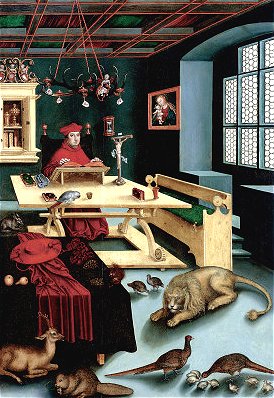 |
|
Cardinal Albrecht of Brandenburg as Saint Jerome
by Lucas Cranach the Elder German 1472-1553
SN 308, Oil on Panel
by Robert Anderson.
Artist:
Cranach was one of the most famous and representative German painters of the 16th century.
As court painter to the Saxon Elector Duke Frederick the Wise he met and became a good
friend of Martin Luther. While he was the chief visual propagandist for Luther and the
Lutheran faith during the Reformation he also contiued working for Catholic patrons such
as Cardinal Albrecht of Brandenburg. Cranach executed many versions of standard Catholic
devotional themes such as The Virgin and Child, but is best known today for his
mythological scenes and for his portraits. Most of Cranach's male portraits, especially of
rulers and other prominent men of political and religious affairs are strikingly
assertive. A contemporary of Albrecht Durer of Nuremberg, Cranach often turned to Durer's
prints for inspiration. He became very wealthy and an important member of the Wittenburg
city council, being elected burgomaster on three occasions. Along with Durer, he played a
key role in the initial development of printing woodcuts in color, which led to the
chiarosco woodcut. |
Subject:
Cardinal Albrect of Brandenburg was a powerful prince of the Church who, while an
enlightened patron of scholarship and the arts, had a somewhat tarnished reputation for
luxurious living and unseemly relationships with women. This was at the time of the
Counter Reformation when the Catholic Church was losing influence and was trying hard to
curb abuses by the clergy and so defend against inroads made by Protestant Reformers. The
Cardinal wished to be portrayed to viewers as a devout and scholarly cleric and therefore
had himself portrayed as Saint Jerome. Such portraits were often done in the guise of
religious figures so as to inform the viewer of the beliefs and values of the sitter.
Saint Jerome was both devout and a scholar of the first order. He had
lived an ascetic life devoted to the Church and had devoted much of his life to study,
contemplation and church administartion. His crowning achievement was the translation of
the Bible from Hebrew into Latin - the Vulgate whichremains as the greatest & most
influential literary achievement of the 4th century. He was therefore a perfect figure for
the cardinal to model himself upon for the portrait.
Painting:
The painting shows Cardinal Albrecht as Saint Jerome seated at his desk in a rather
contemporary study. A chandelier, called a Lusterweibchen, hangs from the ceiling. It is
similar to the one hanging over the picture in our gallery. The painting has an elaborate
symbolic program which would have been read and understood by educated people of the day.
In the foreground are a lion, Jerome's companion in the desert; a beaver symbolic of
industriousness, a squirrel indicating frugality, a parrot to signal the Annunciation, in
addition to pheasants, a peacock, an apple and a deer - all symbolic of characteristics
Albrecht wanted associated with himself.
The composition is a virtual mirror image of Durer's famous print of St.
Jerome in his study, which is not surprising as Cranach often turned to Durer's prints for
inspiration. Cranach was the first to assimilate the lessons to be learned from Durer as
to the use of luminous color, landscape detail and incisive portraiture. This latter
quality can be seen in the forceful and assertive appearance of Albrecht as Jerome.
The painting was purchased by John Ringling in 1932 and was last shown in
the Masterpieces of Art exhibition at the Los Angeles County Museum of Art in 1957.
Historical Context:
The portrait was painted in 1526 some seven (7) years after Martin Luther nailed his
ninety five theses to the church door in Wittenberg. The Reformation was in full swing.
Albrecht was a staunch foe of Luthers - he hated Luther - and it might seem strange that
he should turn to Cranach, a Protestant artist, to paint his portrait. It is thought that
he chose Cranach over other artists, including Durer and Grunewald, as he believed Cranach
could best portray the qualities of devotedness and learning to the viewer. This was
necessary for such a highly ranked ecclesiastic at this point in the Counter Reformation,
when every attempt had to be made to rebut the charges of corruption being leveled at
Church leaders by Protestant Reformers.
ringlingdocents.org
|
